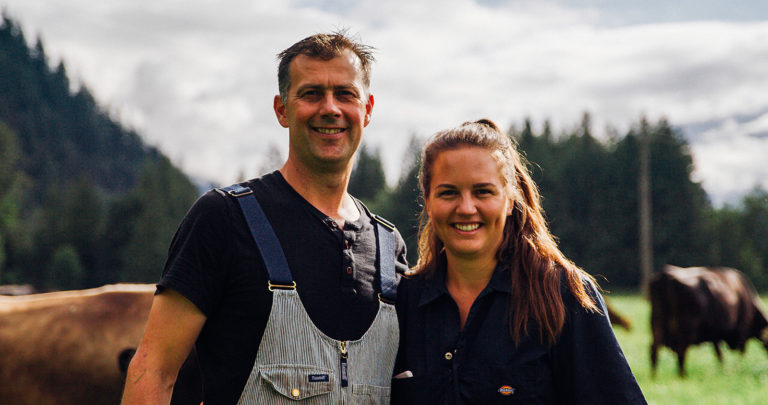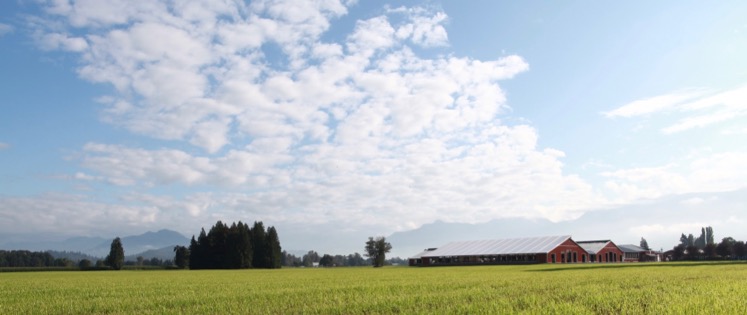The average dairy cow in BC produces 9500 litres of milk a year. To produce high-quality milk, they eat about 50 kg of food every day.
A dairy farmers’ commitment to providing high-quality milk begins with taking good care of his or her cows. The average dairy farm in BC has about 135 milking cows—that’s enough to keep a farm family carefully attending to their animals around the clock. Read on to discover how the cows on Canadian farms make the milk we all enjoy.
How does a cow make milk?
Breeding
Before cows can make milk, they must give birth to a calf. Typically, cows become pregnant with their first calf at a year and a half of age. Farmers usually know a cow is ready to be bred by her behaviour. Dairy farmers spend many hours in their barns each day, and as a result, know their herd well. When a cow enters a fertility period (also known as a “heat”), she is usually bred shortly thereafter. Depending on the farm, female cows are either bred by a bull, or through a process known as AI. Some farms have a bull on farm, and use a combination of bull breeding and AI.
Pregnancy and Calving
Farmers have a close relationship with their veterinarian, who makes routine visits to their barn. A farm’s vet checks up on cows that are bred in order to confirm pregnancy. These checks are important to monitor the herd, but also for the health records of individual cows.
A dairy cow will have her first calf when she is around two years old. Since farmers keep detailed records, they watch their cows carefully around due dates. Most cows calve unassisted, but sometimes a cow requires their farmer’s intervention if the birthing process proves prolonged or difficult. Veterinarians are on call should a complication in delivery arise.
Calves are usually delivered in a part of the barn separate from the rest of the herd, where the mother cow has privacy and her own space. The farmer prepares the delivery area by providing fresh, clean, and comfortable bedding.
Cow and Calf Care
Witnessing or assisting in a birth is a humbling experience for many farmers. Even those who have been farming for a long time report that it is a miracle each time a calf is born.
After a cow gives birth, the farmer immediately attends to her needs, and the needs of the calf. The farmer inspects the calf to make sure that he or she is in good health and with time, able to stand. At this time, the mother typically licks the baby clean, or is assisted by the farmer, who may towel dry the calf.
The first feeding is very important to a calf’s wellbeing, as its mother’s milk contains essential nutrients required to protect from diseases and build its immune system. The milk a cow produces after giving birth is called colostrum. Colostrum is thick, creamy and golden-hued. Calves should drink colostrum within the first few hours of their life.
Most farmers, after performing a health check, milk the cow shortly after birth. This practice ensures that there is enough colostrum to feed her calf right away. The farmer will typically bottle feed to make sure the calf receives all the colostrum he or she needs.
The health of both the mother cow and calf are monitored closely during this time. The farmer makes sure the mother cow is comfortable, with access to nutritious food and water as she recovers from birth. Additionally, the farmer then records the calf’s birth date, gender, and names the calf.
Transition to Milking
The majority of milk produced on a dairy farm is for the purpose of feeding Canadian families. In a dairy system, cows produce many times more milk than their calves are able to drink. Once calves are deemed healthy, they are typically moved to the calf nursery to be cared for by the farmer.
The farmer is able to monitor the calf closely, ensuring it receives the nutrition and medical care needed to get a strong start in life. Caring for calves individually in their early stages also decreases the likelihood of them contracting an illness disease before their immune system is fully developed.
The cow returns to the main part of the barn and joins her herd-mates. Dairy farmers follow standards of care outlined in the Code of Practice for the Care and Handling of Dairy Cattle to assist in the care of both their calves and cows. The code of practice was developed by the National Farm Animal Care Council and Dairy Farmers of Canada, with input from the Canadian Federation of Humane Societies, as well as animal welfare researchers and government experts.
The Milking Process
Dairy cows are most comfortable when they maintain a consistent milking routine. Cows are typically milked twice a day, or increasingly, choose their own time to be milked.
On a farm where cows are milked twice a day, the farmer typically wakes up early and makes his or her way to the barn. At this time, the herd is guided into the milking parlour, where the farmer has the chance to take a look at each cow and clean her udder. The farmer then attaches a milking machine, which is made from soft rubber or silicone suction cups. These suction cups are fitted around each teat to create a vacuum, which causes the milk to be released by gentle pulsation (without causing discomfort for the cow!). It takes about five to eight minutes for milking to be complete.
Milk machines are automatically removed when a cow is done milking. She can then head back into the barn to eat, drink, relax and socialize with her fellow herd-mates.
Cows produce milk for about 10 months. After a 10-month period, each cow will have two months of rest. This period of time (known as “the dry period”) is important for cows to rest and prepare to give birth to another calf. While a cow is taking a two-month rest, the farmer adjusts her diet, with the help of an animal nutritionist. This adjustment ensures she has the right balance of nutrients to promote a healthy birth.
From Field to Table
Dairy cows are ruminant animals. This means they have a unique digestive system made up of 4 stomach compartments, with each compartment playing a specific role in assisting digestion. The rumen and the reticulum are primarily for eating and breaking down food into smaller pieces, whereas the omasum and the abomasum are used for digesting food.
The udder has four ‘quarters’ where milk production occurs. It can take up to two days for a cow’s food to become milk. On average, a cow can produce anywhere between 25 and 40 litres of milk per day. This milk is stored in a sterilized bulk tank on farm, and a licensed milk truck grader picks it up every second day. To learn more about how milk goes from the farm to your table, check out the journey of milk!



